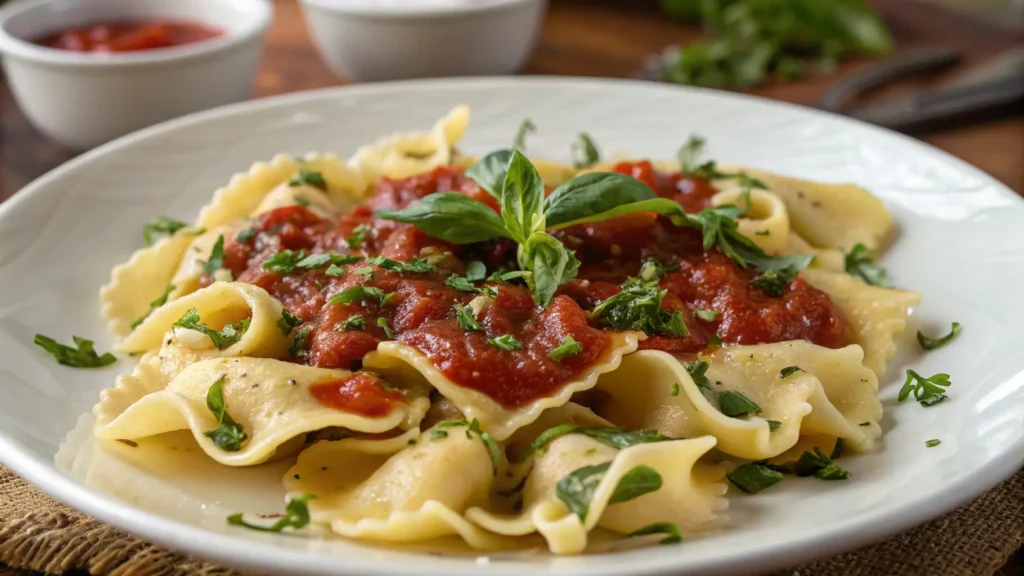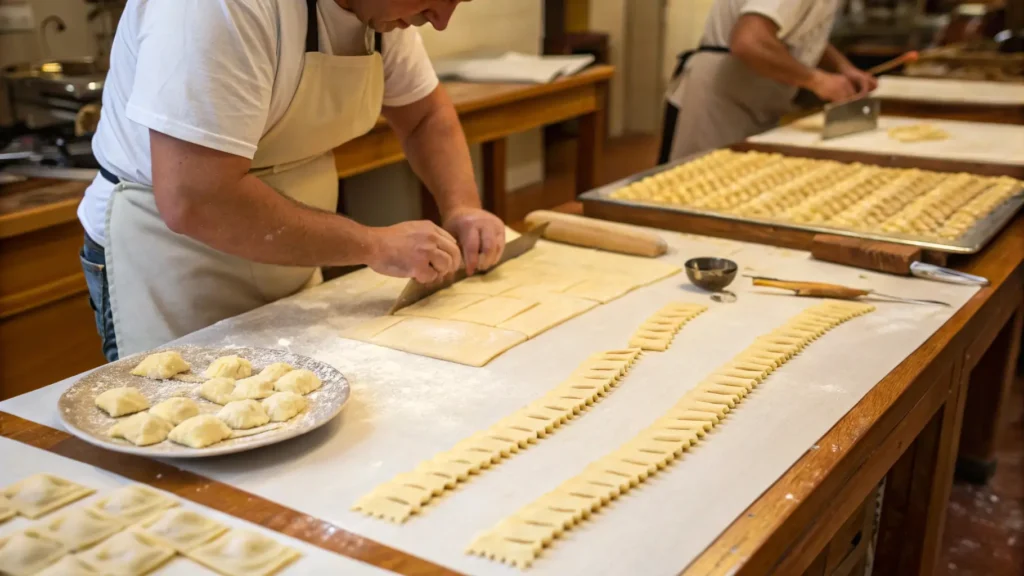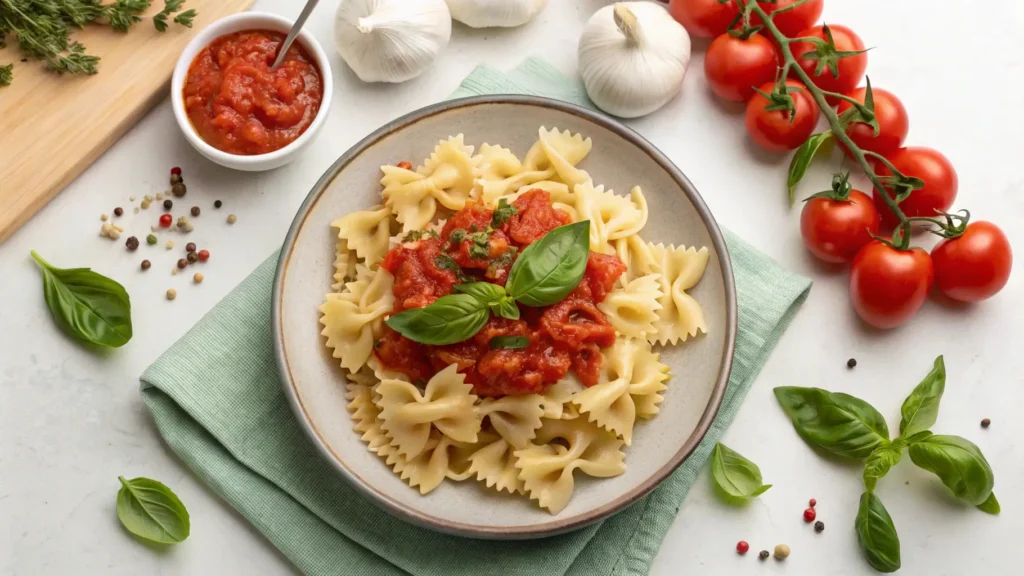Gigli, with its delicate bellflower shape and captivating culinary versatility, has enchanted food enthusiasts worldwide. In this guide, we’ll explore its origin and cultural significance, delve into how it’s made, and uncover delectable recipes to bring its charm to your table. Whether you’re a seasoned chef or a pasta novice, this article will inspire you to appreciate and experiment with this extraordinary Italian creation. Let’s begin by understanding what makes this unique pasta so special.

What is Gigli Pasta?
Introduction to Gigli Pasta
Gigli pasta, also known as campanelle pasta, takes its name from the Italian word for “lilies” or “bells.” Its distinctive shape—flared, ruffled edges curling into a cone—gives it a striking appearance. This pasta isn’t just pretty; it’s also highly functional. The unique design helps it trap sauces, ensuring every bite bursts with flavor.
Unique Characteristics of Gigli Pasta
What sets gigli pasta apart from other Italian pasta varieties? It’s the perfect blend of texture and structure. Its ridges and crevices hold chunky sauces like a charm, while the sturdy dough maintains a delightful chewiness. Gigli’s versatility allows it to shine in baked dishes, hearty stews, and even light summer salads. No matter how you serve it, this pasta brings an air of elegance and authenticity to any meal.
History and Cultural Significance
Origin and Historical Context
The roots of this pasta can be traced back to the culinary heartland of Italy, a country known for its deep pasta traditions. Often associated with the Tuscan region, it reflects Italy’s devotion to creating food that is both beautiful and practical. Historically, gigli was handmade, shaped with care to mimic the graceful curves of a lily.
During celebrations or special occasions, gigli’s ornate design symbolized prosperity and abundance. Over time, it became a beloved choice for families and chefs looking to add flair to their dishes. While modern production methods have streamlined its creation, gigli pasta retains its artisanal charm, reminding us of its rich heritage.
Symbolism and Culinary Identity
More than just a type of pasta, gigli pasta embodies the spirit of Italian cuisine—an art form that values aesthetics as much as taste. Its bellflower shape symbolizes grace and joy, making it a popular choice for festive meals.
Today, gigli pasta’s appeal extends far beyond Italy, winning hearts around the globe. Its versatility and elegance make it a go-to ingredient for those seeking to elevate their culinary creations. By embracing this pasta, you’re also connecting to centuries of Italian tradition and innovation.
How is Gigli Pasta Made?

Traditional Preparation Methods
Crafting gigli pasta by hand is a true labor of love. Traditionally, this pasta is made using simple yet high-quality ingredients—flour, water, and sometimes eggs. The dough is kneaded until smooth, then rolled out and carefully shaped into its signature bellflower form. Each piece is a small work of art, reflecting the passion of the pasta maker.
The ridged edges and open center of gigli aren’t just for show—they serve a functional purpose, holding onto hearty sauces or creamy blends with ease. This traditional method ensures that the pasta maintains the perfect balance of flavor absorption and texture.
Industrial Production Techniques
In modern times, gigli pasta is often produced on a larger scale to meet growing demand. Specialized machinery replicates the intricate shapes, ensuring consistency without sacrificing quality. Despite the shift to industrial production, premium brands prioritize authentic ingredients and processes to maintain the pasta’s unique character.
Whether handmade or machine-crafted, gigli pasta continues to be a staple in Italian kitchens and beyond. Its timeless appeal lies in its blend of artistry and practicality, making it a standout choice for both traditional and contemporary dishes.
Recipes and Serving Suggestions
Classic Recipes Featuring Gigli Pasta
this pasta’s bellflower shape isn’t just stunning—it’s also incredibly functional, making it a perfect choice for traditional Italian recipes. A classic dish to try is Gigli al Forno, a baked pasta delight featuring a hearty meat sauce, creamy béchamel, and layers of gooey cheese. The ruffled edges of gigli pasta soak up the sauce, delivering a burst of flavor with every bite.
For a lighter option, consider Gigli Primavera, where the pasta is tossed with sautéed seasonal vegetables and a drizzle of olive oil. This recipe highlights the versatility of gigli pasta, allowing its unique texture to shine even in simple preparations.
Modern Twists on Gigli Pasta Dishes
For those looking to explore creative culinary possibilities, this unique pasta pairs wonderfully with innovative ingredients and techniques. Why not try a Vegan Gigli Alfredo? By swapping out traditional dairy-based sauces for creamy cashew alternatives, you can create a dish that’s just as indulgent yet entirely plant-based.
Another contemporary option is a Mediterranean Gigli Pasta Salad. This cold dish combines the pasta with sun-dried tomatoes, olives, feta cheese, and a tangy lemon vinaigrette. It’s an excellent choice for summer gatherings or quick weeknight meals.
For more delicious pasta inspirations, you can explore this recipe article on lumache pasta.
Benefits of Gigli Pasta

Nutritional Value
this unique pasta isn’t just about taste; it also offers a solid nutritional profile. Typically made from durum wheat, this pasta provides a good source of complex carbohydrates, which are essential for sustained energy. It also contains dietary fiber and small amounts of protein, making it a balanced addition to any meal.
For those with dietary restrictions, many brands now offer gluten-free versions made from alternative flours like chickpea or rice. These adaptations ensure everyone can enjoy the beauty and taste of this unique pasta.
Culinary Advantages
One of the standout benefits of this pasta is its ability to elevate a wide range of dishes. Its unique shape and textured surface cling to sauces exceptionally well, ensuring maximum flavor in every bite. Whether it’s a rich ragu, a creamy Alfredo, or a simple garlic and olive oil sauce, gigli delivers a restaurant-quality experience.
By choosing gigli pasta, you’re not just enjoying a meal; you’re savoring a piece of Italian tradition that brings elegance and functionality to your plate.
Where to Buy and Store Gigli Pasta
Buying Tips
Finding high-quality gigli pasta can make a world of difference in your dishes. When shopping, look for pasta made with durum wheat semolina, as it offers the best texture and flavor. Artisanal brands often go the extra mile, ensuring the pasta’s bellflower shape is precise and uniform.
Many grocery stores carry this pasta, but for the most authentic options, visit specialty Italian food markets or explore online retailers. Popular brands like Barilla and De Cecco frequently include it in their offerings. If you’re aiming for gluten-free varieties, check health food stores or online shops specializing in alternative pastas.
Storage Guidelines
Proper storage is key to preserving the quality of your gigli pasta. For dry pasta, keep it in a cool, dry place in an airtight container to prevent moisture and pests. Avoid storing it near strong-smelling foods, as pasta can absorb odors over time.
Cooked gigli pasta can be refrigerated in an airtight container for up to three days. For longer storage, consider freezing the pasta after tossing it lightly in olive oil to prevent clumping. This ensures your pasta is ready for quick and delicious meals whenever you need it.
FAQs About Gigli Pasta
What is the difference between Gigli and Campanelle pasta?
Gigli and campanelle are often used interchangeably, but they have subtle differences. While both feature a flower-like design, gigli’s ruffled edges and more pronounced cone shape set it apart.
Can Gigli pasta be used in cold pasta salads?
Absolutely! Gigli pasta is an excellent choice for cold salads due to its ability to hold dressings and chunky ingredients. Its shape adds a decorative touch to any dish.
Is Gigli pasta suitable for gluten-free diets?
Yes, many brands now offer gluten-free versions made from rice, quinoa, or chickpea flour. These options provide similar texture and flavor while catering to dietary needs.
Exploring this unique pasta opens up a world of culinary possibilities, from hearty main courses to elegant side dishes. Its versatility and beauty make it a must-have for every pasta lover.

